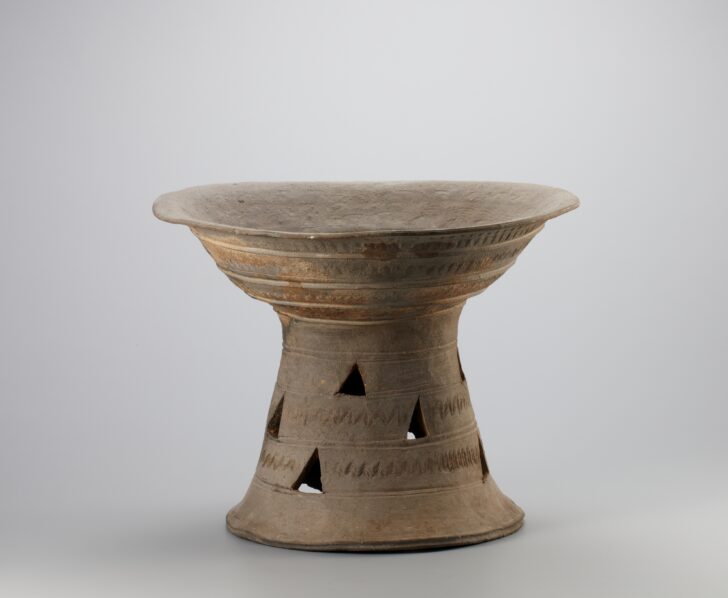Large bowl or stand on high cut-out pedestal foot
Korean

Description
This impressive piece may have held offerings of food or served as a stand for a very large, round-bottomed jar. Both the bowl and stand are decorated with horizontal registers of incised wavy lines, separated by raised bands.
Maribeth Graybill, The Enduring Art of the Korean Potter, December 12, 2004-November 6, 2005
Subject Matter:
Footed bowl was found in the Three Kingdom and Unified Silla. It is one of the ritual vessels. It can be found in every tomb of that age. It is almost grayish-blue stoneware. At the beginning, It didn’t have lid and perforation. From 4C lid and perforation was made. Footed bowl is divided Silla style and Gaya style. The lid and bowl of Silla style are thick and the leg is slim. The perforation is located in altering position. In contrast, the lid and bowl of Gaya style is very flat and the leg is thick. The perforation is positioned in parallel.
Physical Description:
It has wide flared bowl supported by a little flared pedestal foot. Three raised band lines encircle the middle of the bowl. The foot which is separated into 3 parts and has a lot of triangular holes gives the whole bowl stability. There is a tiny wave design on the surface of the bowl and foot
This is a gray, bowl-shaped, high-fired stoneware vessel stand. The bowl-shaped body flares widely until it spreads horizontally to reach the round rim with grooves. The body is divided by three raised bands into four sections, each of which features a wave design rendered using a multi-tooth comb. The pedestal is divided into five sections by horizontal ridges. Each of the three central sections features four triangular perforations; the lower two of these three central sections are also decorated with wave designs between the perforations. The edge of the pedestal base is narrow and grooved. The inner surfaces of the bowl-shaped body and pedestal show traces of a round inner support anvil that was used when paddling the vessel walls.
[Korean Collection, University of Michigan Museum of Art (2017) p. 55]
Usage Rights:
If you are interested in using an image for a publication, please visit https://umma.umich.edu/request-image/ for more information and to fill out the online Image Rights and Reproductions Request Form.